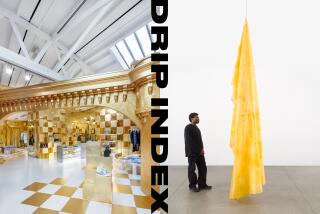Pen collectors going strong even as handwriting dwindles
The discussion over minute details at a Manhattan Beach hotel ballroom seemed endless: Is the ink chamber filled with a pump, a button or an eyedropper? Was the pen exposed to heat or humidity, which darkens its color and decreases its value?
For the 25th year, the Los Angeles International Pen Show convened Thursday, with about 1,200 exhibitors and collectors expected to gather at the local Marriott hotel.
On Sunday, the last day, the show opens to the public for $7 at the door. The pens, though, cost significantly more, starting a little below $100 and breaking seven figures on the high end.
At those prices, it’s easy to see the focus on details. But show organizer Chris Odgers, whose day job is as a vice president licensing content for Warner Bros. Pictures, noted that pen culture is about more than the minute details.
“People that do this are about preserving and telling some history,” Odgers said.
Pen lovers honor craftsmanship and a personal touch, even as communication moves to keyboards and touch screens, he said. They keep journals and write letters. Many emphasize penmanship and mourn the loss of cursive writing education in schools.
Nationwide, the focus on penmanship has fallen. Annual shipments in the pen and mechanical pencil industry fell 36% from 2002 to 2007, according to U.S. census data.
However, the collecting culture has thrived, thanks to a group of doctors, lawyers, artists and architects who still like the way a nib, or fountain pen tip, makes their handwriting look.
By day, lawyer Cliff Harrington represents large media companies before the Federal Communications Commission in the nation’s capital.
But every so often he dons a drab button-down and plants himself behind a folding table at the dozen pen shows he attends each year.
“I’ve been coming here for 20 years,” Harrington said. “The pens are always very interesting here.”
For some, pens are also good business. Fred Krinke’s Monrovia store, the Fountain Pen Shop, has been in the family since his grandfather opened it in downtown Los Angeles 91 years ago.
Krinke, who has attended the show every year since it began, helps promote the event because the conventions are an important way to create new collectors and keep his business strong, especially as interest in handwriting declines.
“The more people that come, the better it is for us,” Krinke said.
Some collectors obsess over pens from a certain company or time period. Others crave custom-made caps and inkwells. And some simply covet pens that are, say, blue.
Rita Lott, 49, of Dakota Dunes, S.D., inadvertently launched her husband’s pen collection when she bought him a fountain pen as a wedding gift 20 years ago. Robert Lott, also 49, now owns about 500 pens. On Thursday he added two more: two 14-carat gold Waterman Taper Cap fountain pens, together valued at more than $20,000.
“Was I looking for them? No,” said Robert, a retired Army lieutenant colonel. “But when a pen like that surfaces, you just have to step up and do it because you love it.”
Although her husband has amassed “a sickening amount” of pens, Rita said, she appreciates that going to the conventions gives her the opportunity to travel.
“We’ve met a lot of friends, and it’s something we’ve been able to share,” she said as her husband peered through bulky jeweler’s goggles to check a pen for cracks and blemishes.
A few tables down, Bob Novak, 61, of New York spread out his wares and eyed the competition. He’s part of a cadre of dealers who crisscross the country attending pen shows, buying pens the way investors buy stocks.
“It’s a lot of fun, and you can make some money if you’re good,” Novak said. “It’s all about what kind of information you have.”
A man wandered over to his table and selected a marble-patterned fountain pen, rolling it between his fingers, then handed it back.
Novak didn’t let the sale go so easily: “$600,” he said encouragingly, “$600. How many of these do you see around?” But the man moved on.
For his own writing needs, Novak sticks with an unsentimental ballpoint.
Ballpoint pens began mass production in the early 1900s, and Pen World editor Laura Chandler said they have far fewer fans in the pen-collecting world.
Although they’re more reliable, ballpoints draw a uniform width line with a ball bearing instead of a nib.
And a pen’s personality is all in the nib, Chandler said.
A person’s handwriting style is determined by what materials the nib is made of, how much it flexes, how the writer grips the pen and how hard he or she presses down on the paper. Unlike ballpoint pens, touch screens and text messages, a fountain pen always leaves a distinctive mark, Chandler said.
“There’s no technology that does everything,” Chandler said. “People will never give up their pens because it’s more than just writing. Everyone has to make their own signature.”







